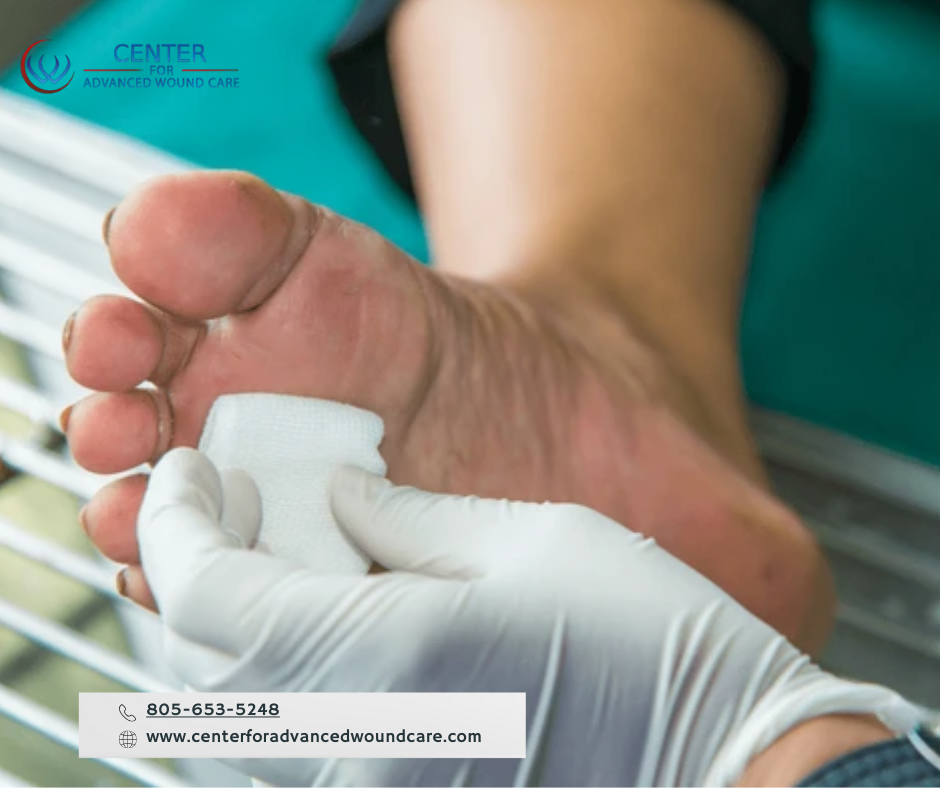
Why Diabetes Foot Ulcers Are Considered Chronic Wounds and How to Manage Them?
Summary
Diabetic foot ulcers are deemed to be chronic wounds because they develop from defective healing as a result of reduced blood flow, neuropathy, and compromised immune status. If diabetic foot ulcers are not treated, they may cause severe consequences such as infection and amputation. Treatment that is successful incorporates proper wound management, glycemic control, offloading, and sophisticated therapy in the form of dressings, debridement, and hyperbaric oxygen therapy. Timely detection and expert care will help avert severe consequences.
Diabetic foot ulcers are a common and serious issue for people with diabetes. About 15% of these patients get them.
These ulcers are open sores that usually form on the bottom of the foot. They are called chronic wounds because they heal slowly without the right care.
Diabetic foot ulcers can last a long time. Understanding why this happens and how to treat them is important. It can help prevent serious problems, like infections and amputations.
Why are diabetic foot ulcers considered chronic wounds?
Chronic wounds are characterized based on the slow or failed progress of the healing phases. Several factors that contribute to the chronic nature of DFUs include:
The Periphery of Neuropathy
One of the most frequent consequences of chronic hyperglycemia in diabetic patients is peripheral neuropathy. Hyperglycemia can harm nerves through several processes, including ischemia, oxidative stress, and the buildup of fructose and sorbitol inside the nerve cells. The symptoms of nerve damage include sensory, motor, and autonomic dysfunctions.
Damage to sensory nerves results in a loss of protective sensation. Most individuals do not feel pain arising from minor injuries or pressure over their feet; as a result, sores progress without a patient’s perception of the fact and can go all the way to becoming an ulcer.
Autonomic Neuropathy: Damage to the autonomic nerves impacts the sweat glands, causing less sweating. With less sweating, the skin dries up and cracks develop in this cracked surface through which bacteria enter, hence predisposing the individual to infection.
Motor Neuropathy: Weakness, atrophy, and imbalance result from damage to motor nerves. Claw toes or hammertoes result in abnormal pressure points on the foot, thus increasing the potential for ulcer formation and skin breakdown.
Poor Circulation
Diabetes narrows and thickens the blood vessels supplying the lower limbs, thus causing peripheral arterial disease. Reduced blood flow subsequently impairs the delivery of oxygen and nutrients for healing and tissue formation. To begin with, impaired circulation slows down the healing but also makes an individual more vulnerable to infections since an adequate delivery of immune cells to the wound site is impossible.
Immune System Impairment
Chronic hyperglycemia adversely affects the functionality of the immune system. Since blood glucose is high, white blood cells are not effective in combating infections, and thus they are less powerful. Immune suppression occurs in individuals with diabetes and increases their vulnerability to infections. This in turn complicates the healing process of foot ulcers.
Pressure and Foot Deformities
Common foot structural deformities include bunions, hammertoes, or Charcot foot among diabetic patients, especially when they have a neuropathy component. Such alterations in foot pressures change the loading of forces distributed over the footprint when a diabetic patient walks or stands. Since pressure areas easily cause skin failure, it follows that such will develop calluses that will finally ulcerate. Neuropathy and foot deformities make a vicious cycle where the patient is not aware of the increased pressure and resultant damage, creating an environment that allows ulcers to develop and persist.
Effective Management of Diabetic Foot Ulcers
Managing DFUs requires a comprehensive approach that addresses the underlying causes and promotes optimal healing conditions. Key strategies include:
Blood Glucose Control
The most fundamental aspect is keeping glucose levels in the target range. Optimal glycaemic management reduces problems and encourages the body to repair.
Routine foot checks
The patient with diabetes will have to check his feet daily to determine the early onset of cuts, blisters, or infections. Regularly checking the foot for a problem diagnosed by the doctor is equally important.
Pressure offloading
The ulcerated area has to have pressure released. Offloading braces or special shoes helps shift the patient’s body weight away from the ulcer site by promoting healing.
Wound Care
To keep the healing environment moist, proper wound care entails cleaning the ulcer and removing dead tissue using the proper dressings. Chronic wound treatments that utilize advanced nitric oxide have shown the potential to improve wound healing.
Circulation Improvement
The assessment of a patient’s circulation may indicate the need for the patient to have procedures to enhance circulation, hence supporting the healing process.
Management of Infections
Appropriate antibiotic treatment is required if infected. Hospitalization is required for more extensive care and injectable antibiotics for more severe illnesses.
Education of the patient
Educating the patient on proper foot care is a must. The need for blood sugar control and early signs of complications empowers the patient to take proactive steps in managing the condition.
The Specialists and Wound Care Clinics’ Role
DFU chronic wounds are treated in specialized wound clinics. Healthcare professionals, such as podiatrists who provide diabetes foot ulcer treatment, are available at wound clinics. When it comes to ulcerative foot sores, podiatrists have preventative, diagnostic, and therapeutic roles to play.
Procedural interventions of debridement can be made by a podiatrist. In addition, referring patients for advice on offloading devices and shoe selection works best for recurrence prevention.
This suggests that vascular surgeons, endocrinologists, podiatrists, and infectious disease specialists may be present in wound therapy clinics. Together, these experts offer patients individualized care that is tailored to their specific needs.
Preventive Measures
For individuals suffering from diabetes, prevention of DFUs is vital since they could easily become complications if left unchecked. Wearing proper footwear, avoiding walking barefoot, and receiving professional foot care from a health provider reduce the likelihood of ulcer formation.
Wearing Appropriate Footwear
Proper fitting and good support in selecting shoes can also prevent pressure points that may develop into ulcers. Diabetic-friendly shoes have to be fitted roomy enough, cushioned and have breathability features to protect a person from possible injuries and infections. Some features to look at include:
Fit: The shoes should fit the foot without compression in any region prone to ulceration.
Cushioning: Sufficient cushioning provides shock absorption, reduces pressure on the soles of the feet, and consequently, the likelihood of skin breakdown.
Breathability: The material used must have good ventilation. This means air can get in and dry the feet; the risk of fungal infections will thus be decreased.
A study published in Diabetes Care, one of the top journals associated with diabetes, was conducted to show the effectiveness of therapeutic footwear in reducing plantar pressures and new ulcerations. This study demonstrated that patients with diabetic foot ulcers who used therapeutic footwear compared to non-therapeutic footwear had significantly reduced foot pressure and fewer new lesions.
Avoiding Barefoot Walking
Walking barefoot increases the chance of getting a foot injury such as a cut or abrasion, leading to ulcer development in individuals who are neuropathic and thus might not be able to feel them. To avoid this risk:
Always Wear Shoes or Slippers: Even at home, the protective footwear can prevent accidents.
Always Inspect Footwear Before Use: Ensure that nothing untoward gets lodged inside shoes causing damage.
Appropriate Footwear for Activities: There must be a suitable selection of the types of shoes based on the activity to ensure adequate protection along with enough support.
Regular Professional Foot Care
Routine visits with a podiatrist are considered essential for caring for the overall health of a foot and possibly preventing minor ulcers from appearing. Podiatrists are generally specialized in cases of foot, ankle, or related conditions as well as procedures like:
Callus and Corn Removal: The safe removal of calluses and corns, which may ulcerate if not managed properly.
Nail Care: The toenails have to be trimmed and managed regularly so that they don’t grow inward and cause trouble.
Foot Evaluation: Regular monitoring to look for early indications of a problem, such as deformation or high-pressure areas.
Conclusion
Diabetic foot ulcers, also abbreviated as DFUs, represent long-term wounds linked to conditions such as neuropathy, impaired circulation, and weakened immune systems as a result of diabetes. Management strategies include blood glucose control, wound care, offloading pressure, and patient education. Wound care clinic and specialists like podiatrists facilitate better outcomes and increase the prevention rate of severe complications, such as amputations. Preventive strategies range from proper footwear and regular foot examinations for diabetic patients.
Specialized centers, like the Center for Advanced Wound Care, are designed to offer comprehensive services to diabetics, including advanced wound dressings and podiatry services, among others. Using state-of-the-art treatments and a multidisciplinary team of wound doctors, the primary goal to prevent amputations can be achieved. When such expertise is included in a patient’s care plan, results can be maximized, with increased healing rates and lowered complications from this disease.


